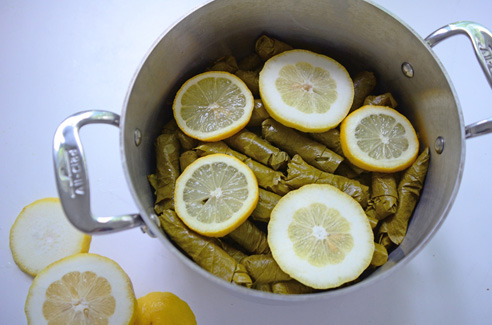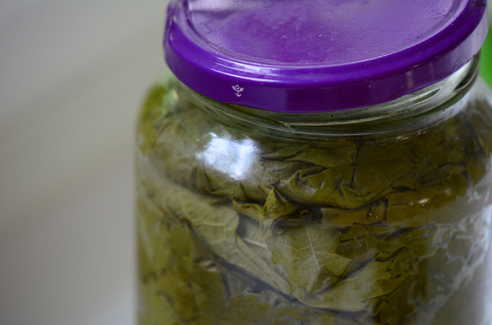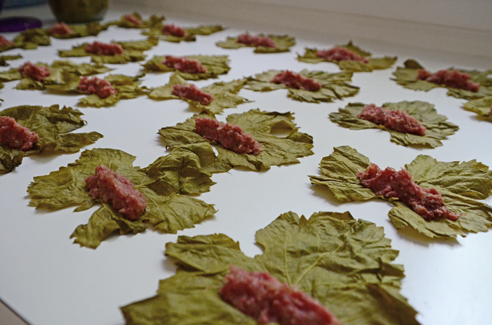

There is one thing I've always thought was a given about grape leaves: that fresh is best. In other words, that leaves picked when they've just unfurled from the vine in the spring and eaten immediately make the finest little stuffed rolls.
Or so I thought, until I met my father's cousin May, and therefore my cousin May, in Lebanon recently. May spoke to me of my father's family village of Dier Mimas, a place I've held in my lifelong imagination. She had heard we would not be traveling to the village, and she wanted to know why. My response pained me, as it did her, but I thought it best to simply out it: I want to go there very badly, but we don't think it's safe. The village is at the southernmost point of Lebanon, on the Israeli border. Safe? It's fine! May said. Then Aunt Augette, a commanding beauty of a matriarchal woman, chimed in and saved me: No, it is not safe, and they should not travel there. Period. The End.

We spoke then of the thousands of grape leaves May picks in her home village every year. They live in Beirut now, as many do, and travel to their villages every weekend to relax and see the family. May preserves the leaves of Dier Mimas not by freezing them, but by jarring them in water and salt.
May told me she prefers to jar her leaves because they retain a nice color and have great flavor. Then she offered to make some for us so we could taste her pride and joy. Then she offered to send a jar home with me. Good manners would have refused but I couldn't help myself from saying yes on every count. And the look on her face reminded me that good manners, Lebanese-style, is to accept the invitation of family and food, to eat, to enjoy, and to recognize the gift of the cook that you have been given.

And what a gift it was. We had decided on this dinner just the night before, but here was a spread that would take most of us days to prepare: kibbeh nayeh (yes, we ate it raw more than once in Lebanon; it was spicy and delicious), kebab with toum sauce, tabbouleh, hummus, labne, and a massive platter of Dier Mimas grape leaves. She'd made 300 tiny rolls that day. Also plates of green plums and kumquats (such color!), Lebanese wine and arak graced the table. Then desserts of all sorts filled the table, including the Lebanese ice cream I'd been pining after the whole trip. But even my sweet tooth couldn't help but be dazzled instead by the fava beans that were handed to each person straight from a brown bag from the market. We plucked them from their pods, popped the beans from their skins, salted them, and ate. What a contrast to the precious eating of favas that takes place in restaurants all spring. It was the finest palate cleanser I've ever had.
I was in the kitchen before dinner and May showed me her stuff, her way of kneading the kibbeh, her way of combining the tabbouleh with all of its components prepared and waiting for this moment in the refrigerator, and her way of demonstrating that here in her kitchen was the epicenter of the family. Her gorgeous children and husband buzzed all around her, teasing and laughing. You like my home? May asked with a smile in her broken English. Oh yes, I like your home. In walked more cousins and more, and the elders whose faces I knew even though I had never seen them before. One of these women, Aunt Miriam, wore a black and cream silk blouse and first thing she said, showing off her blouse, was: your Aunt Hilda bought me this! It did look just like a blouse Aunt Hilda would buy, and that gifting probably took place 25 years ago.

Aunt Miriam and the others of that generation there with us that night -- they are nieces of my grandmother: my father's mother, Nabeha, who I never met because she died when she was only 49, when my father was only 20, and who I've heard so much about and written so much about that I begin to be unsure of what I've made up and what is actually true about her and about Dier Mimas. I asked Aunt Miriam and Aunt Augette at dinner that night in Lebanon: do you remember my grandmother, Nabeha? Of course! they said. We loved her! She was wonderful!
Of course! I said. It was all too much, and at the same time, not enough. I wanted to trace their faces onto my fingertips and record the sound of their words in my ears. I wanted to go to Dier Mimas, and taste it all. Next time, I said, we will go to Dier Mimas.
My tears flowed freely that night, as they had the night before when I sat at dinner next to Mirna, another young cousin of this clan who spent so much time with my brother Chris and his wife Ruth when they were in Lebanon six years ago adopting little John. Mirna kept Ruth close during what turned into days of war. Mirna took risks for Ruth without another thought (just as Ruth took risks for John without hesitation), driving her through the bombed city to get her and the baby to the military boats so they could leave. I asked Mirna, was that the area just over there on the coast of Beirut where you took Ruth? And here we were looking at a photo of the baby who is no longer a baby but a beautiful little boy whose mother escaped a war, but not the cancer that took her from him.
Can you blame me for the tears of both joy and sorrow?
Or for taking home the jar of grape leaves from the soil of an unreachable Dier Mimas?
Or for writing Rose Water & Orange Blossoms, my blog which is becoming a love letter to history, to family, to food, to that which we know because we taste it, and do not know because we have never been there.
Lebanese Grape Leaf Rolls
The method is the same whether you are using fresh or jarred grape leaves, except the fresh leaves need not be soaked in cold water. To make smaller rolls, cut jarred leaves in half.
80-100 grape leaves, medium size
1 cup long grain rice
1 pound ground beef (90 percent lean) or lamb
½ cup butter, melted
½ tablespoon salt
½ teaspoon freshly ground pepper
½ teaspoon ground cinnamon
2 lamb or pork neck bones, 2 bone-in pork chops, or 6 chicken wings (optional)
3 large grape leaves
2 lemons
Rinse the leaves thoroughly and soak in cold water for 15 minutes. Line a heavy, deep pan with meat bones if using, then three grape leaves. (Line the pan with just the leaves if no meat is being used).
For the filling:
In a medium-size bowl, combine rice, ground beef or lamb, butter, salt, pepper, and cinnamon. Mix well with your hands.
Prepare a dutch oven by lining the bottom with lamb or pork bones, pork chops, or chicken wings. Spread 3 large leaves over the top of the meat.
To stuff and roll the leaves:
Place grape leaves facing vein-side up on work surface with the wide stem-end of the leaf toward you.
Drop oneheaping teaspoon of filling across that stem edge of the leaf, shaping like a finger, leaving enough leaf on either side of the meat for rolling. Don't roll the leaves too tightly -- allow room for rice filling to expand. Fold each side of leaf over the meat like an envelope and roll securely, away from you.
Arrange stuffed leaves in rows in a heavy, deep pan, alternating the direction of each layer of rows. Slice the lemon crosswise into several ¼-inch slices and lay the lemon slices over the rolls. Place a plate face down over the top layer to prevent the rolls from floating.
Fill pot with warm water up to the plate. Cover and bring slowly to a boil. After about 20 minutes, add the juice of one lemon to the cooking water. Some prefer much more lemon than this, or none at all; adjust as you please. Reduce heat to low and simmer for 30-40 minutes, for a total cooking time of about one hour, until rice is tender.
Serve with cooked lemon slices as a garnish and labne.